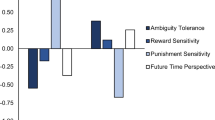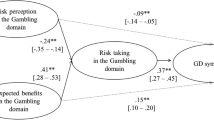Abstract
This research examined whether youth’s forecasted risk taking is best predicted by a compensatory (namely, subjective expected utility) or non-compensatory (e.g., single-factor) model. Ninety youth assessed the importance of perceived benefits, importance of perceived drawbacks, subjective probability of benefits, and subjective probability of drawbacks for 16 risky behaviors clustered evenly into recreational and health/safety domains. In both domains, there was strong support for a non-compensatory model in which only the perceived importance of the benefits of engaging in a risky behavior predicted youths’ forecasted engagement in risky behavior. The study overcomes earlier methodological weaknesses by fully decomposing participants’ assessments into importance and probability aspects for both benefits and drawbacks. As such, the 6findings provide clear evidence in support of a bounded-rationality perspective on youth decision making regarding risk taking.
Similar content being viewed by others
References
Anand P. (1995) Foundations of rational choice under risk. Oxford University Press, Oxford
Baron, J., Brown, R. V. (eds) (1991) Teaching decision making to adolescents. Lawrence Erlbaum Associates, Hillsdale, NJ
Bauman K. E., Fisher L., Koch G. (2006) External variables, subjective expected utility and adolescent behavior with alcohol and cigarettes. Journal of Applied Social Psychology 19: 789–804
Bauman K. E., Udry J. R. (1981) Subjective expected utility and adolescent sexual behavior. Adolescence 16: 527–535
Benthin A., Slovic P., Severson H. (1993) A psychometric study of adolescent risk perception. Journal of Adolescence 16: 153–168
Beyth-Marom R., Fischhoff B. (1997) Adolescents’ decisions about risks: A cognitive perspective. In: Schulenberg J., Maggs J., Hurnelmans K. (eds) Health risks and developmental transaction during adolescence. Cambridge University Press, New York, pp 110–135
Boyer T. W. (2006) The development of risk-taking: A multi-perspective review. Developmental Review 26: 291–345
Cohen J. (1988) Statistical power analysis for the behavioral sciences (rev. ed.). Erlbaum, Hillsdale, NJ
Dhami M. K. (2003) Psychological models of professional decision-making. Psychological Science 14: 175–180
Dhami, M. K., & Garcia-Retamero, R. (in press). Spanish young adults’ perceptions of the costs and benefits of risky driving. The Spanish Journal of Psychology.
Dhami, M. K., & Mandel, D. R. (2011). Crime as risk taking. Psychology, Crime and Law. doi:10.1080/1068316x.2010.498423.
Dhami M. K., Mandel D. R., Garcia-Retamero R. (2011) Canadian and Spanish youths’ risk perceptions of drinking and driving and riding with a drunk driver. International Journal of Psychology 46: 81–90
Dhami M. K., Mandel D. R., Loewenstein G., Ayton P. (2006) Prisoners’ positive illusions of their post-release success. Law and Human Behavior 30: 631–647
DiClemente, R. J., Hansen, W., Ponton, L. E. (eds) (1996) Handbook of adolescent health risk behavior. Plenum Press, New York
Fishburn P. C. (1981) Subjective expected utility: A review of normative theories. Theory and Decision 13: 139–199
Furby L., Beyth-Marom R. (1992) Risk taking in adolescence: A decision-making perspective. Developmental Review 12: 1–44
Garcia-Retamero R., Dhami M. K. (2009) Take-the-best in expert-novice decision strategies for residential burglary. Psychonomic Bulletin & Review 16: 163–169
the ABC Research Group: (1999) Simple heuristics that make us smart. Oxford University Press, New York
Greening L., Stoppelbein L. (2000) Young drivers’ health attitudes and intentions to drink and drive. Journal of Adolescent Health 27: 94–101
Gruber, J. (Ed.). (2001) Risky behavior among youths: An economic analysis. University of Chicago Press, Chicago, IL
Halpern-Felsher B. L., Biehl M., Kropp R. Y., Rubinstein M. L. (2004) Perceived risks and benefits of smoking: Differences among adolescents with different smoking experiences and intentions. Preventive Medicine 39: 559–567
Jessor R. (1998) New perspectives on adolescent risk behavior. Cambridge University Press, Cambridge, England
Kahneman D. (2003) A perspective on judgment and choice: Mapping bounded rationality. American Psychologist 58: 697–720
Kahneman D., Tversky A. (1979) Prospect theory: An analysis of decisions under risk. Econometrica 47: 313–327
Knight, F. H. (1921/1964). Risk, uncertainty, and profit. New York: Sentry Press.
Loewenstein G. F., Hsee C. K., Weber E. U., Welch N. (2001) Risk as feelings. Psychological Bulletin 127: 267–286
Moore S., Gullone E. (1996) Predicting adolescent risk behavior using a personalized cost-benefit analysis. Journal of Youth and Adolescence 25: 343–359
Morris S. B., DeShon R. P. (2002) Combining effect size estimates in meta-analysis with repeated measures and independent-groups designs. Psychological Methods 7: 105–125
Nickoletti P., Taussig H. N. (2006) Outcome expectancies and risk behaviors in maltreated adolescents. Journal of Research on Adolescence 16: 217–228
Parsons J. T., Siegel A. W., Cousins J. H. (1997) Late adolescent risk-taking: effects of perceived benefits and perceived risks on behavioral intentions and behavioral change. Journal of Adolescence 20: 381–392
Reyna V. F., Farley F. (2006) Risk and rationality in adolescent decision making: Implications for theory, practice, and public policy. Psychological Science in the Public Interest 7: 1–44
Romer, D. (Ed.). (2003) Reducing adolescent risk: Toward an integrated approach. Sage, London
Siegel A. W., Cousins J. H., Rubovitts D., Parsons J. T., Lavery B., Crowley C. (1994) Adolescents’ perceptions of the benefits and risks of their own risk-taking. Journal of Emotional and Behavioral Disorders 2: 89–98
Simon H. A. (1956) Rational choice and the structure of the environment. Psychological Review 63: 129–138
Simon H. A. (1982) Models of bounded rationality. MIT Press, Cambridge, MA
Slovic P., Finucane M. L., Peters E., MacGregor D. G. (2002) The affect heuristic. In: Gilovich T., Griffin D., Kahneman D. (eds) Heuristics and biases: The psychology of intuitive judgment. Cambridge University Press, New York, pp 397–420
Weber E. U., Blais A., Betz N. E. (2002) A domain-specific risk-attitude scale: Measuring risk perceptions and risk behaviors. Journal of Behavioral Decision Making 15: 263–290
Author information
Authors and Affiliations
Corresponding author
Rights and permissions
About this article
Cite this article
Dhami, M.K., Mandel, D.R. Forecasted risk taking in youth: evidence for a bounded-rationality perspective. Synthese 189 (Suppl 1), 161–171 (2012). https://doi.org/10.1007/s11229-012-0110-2
Received:
Accepted:
Published:
Issue Date:
DOI: https://doi.org/10.1007/s11229-012-0110-2




